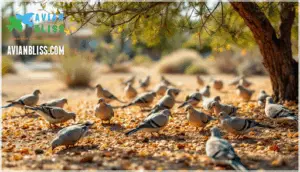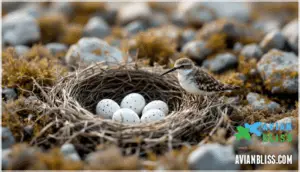This site is supported by our readers. We may earn a commission, at no cost to you, if you purchase through links.

Originally found mainly in southwestern deserts, these doves have expanded their range across much of the United States. They now thrive in cities, suburbs, and wild habitats from coast to coast. Understanding their appearance, actions, and habitat preferences helps you spot these adaptable birds in your own neighborhood.
Table Of Contents
- Key Takeaways
- White-winged Dove Identification
- Habitat and Geographic Range
- Behavior and Diet
- Breeding and Nesting Habits
- Conservation Status and Population Trends
- Frequently Asked Questions (FAQs)
- What does it mean when a white-winged dove visits you?
- What’s the difference between a Mourning Dove and a white-winged dove?
- Are white wing doves invasive?
- How can I attract White-winged Doves?
- Are White-winged Doves year-round residents?
- What is the scientific name of the White-winged Dove?
- Do White-winged Doves migrate long distances?
- What predators threaten White-winged Doves?
- How do white-winged doves interact with pets?
- What predators threaten white-winged dove populations?
- Conclusion
Key Takeaways
- White-winged doves have expanded dramatically from their original southwestern desert range to thrive across most of the United States, with populations growing from a historic low of 500,000 in 1939 to 11.7 million in the U.S. by 2025, primarily due to their remarkable ability to adapt to urban and suburban environments.
- The species can be reliably identified by its bold white crescent marking along the wing edge when perched and broad white wing patches visible during flight, distinguishing it from the slimmer Mourning Dove which lacks these white markings and has a longer pointed tail.
- These doves display flexible breeding and feeding behaviors that support their success, including the ability to nest in diverse locations from cacti to city trees, produce nutrient-rich pigeon milk for their young, and consume a varied diet of seeds, fruits, nectar, and insects from both wild and urban sources.
- Despite facing significant threats including 75% historic habitat loss in Texas, high nest predation rates exceeding 60% in some areas, and annual harvest of about 1.3 million birds in Texas alone, the species maintains a "Least Concern" conservation status due to effective adaptive management and their successful colonization of human-modified landscapes.
White-winged Dove Identification
If you’ve ever spotted a dove and wondered whether it was a White-winged Dove or something else, you’re not alone. Learning to identify this species comes down to noticing a few reliable features.
Let’s look at what sets this bird apart from other doves you might see.
Distinguishing Features and Plumage
When you spot a White-winged Dove, the bold white crescent running along the edge of its folded wing is your best clue—it’s like a signature stripe that sets this bird apart from other doves. The plumage coloration is a soft grayish-brown overall, creating a warm appearance that blends well with desert landscapes.
In flight, those wing markings become even more dramatic as the white stripe expands into a large patch. Juvenile plumage appears slightly duller with less distinct color patterns than adults show.
Size, Wingspan, and Measurements
A White-winged Dove stands roughly robin-sized, measuring about 11 to 12 inches from beak to tail, with wings that stretch between 19 and 23 inches when fully spread. Weight variation in these birds usually ranges from 4.4 to 6.6 ounces.
Sexual dimorphism is minimal, so you can’t tell males from females by size alone.
These measurements place the white-winged dove between the smaller Mourning Dove and the larger Eurasian Collared-Dove in the size spectrum.
Comparison With Mourning Dove
If you’re used to the slender profile of a Mourning Dove, the White-winged Dove will strike you as noticeably chunkier and more rounded. Key differences include:
- Size comparison: White-winged Doves are heavier and stockier
- Plumage differences: White wing patches versus uniform gray-brown coloring
- Call distinctiveness: Deep cooing versus soft, mournful whistles
Both dove species share habitat overlap in many regions, but conduct contrasts help with dove identification.
Key Field Marks in Flight and Perching
When you’re watching one in action, a few standout field marks make identification straightforward, whether the bird is perched or soaring overhead. Look for the white crescent shape along the wing when perched and the striking white stripe prominence that transforms into bold wing patches during flight. The blackish wingtips create a contrast against the pale brown plumage.
| Field Mark | Perched Appearance | In-Flight Appearance |
|---|---|---|
| Wing stripe prominence | Large white crescent visible | Broad white patch on inner wing |
| Tail feather details | Short and square-tipped | Square profile with gray-brown edges |
| Coloration variations | Pale brown body overall | Gray-brown with blackish wingtips |
| Flight pattern distinctiveness | N/A | Steady wingbeats with direct path |
| Whitewinged Dove characteristics | Plump body, small head | White inner wings contrast sharply |
These white-winged dove identification markers help distinguish the species from other doves you’ll encounter.
Habitat and Geographic Range
White-winged Doves aren’t picky about where they set up shop. You’ll find them in a surprising range of places, from wild desert scrub to your neighborhood park.
Let’s look at where these adaptable birds make their home across North America.
Preferred Natural Environments
You’ll find white-winged doves thriving in dry landscapes where trees and open ground exist side by side. Desert habitats like the Sonoran Desert provide ideal conditions with their mix of cacti and mesquite trees.
They also frequent scrublands, grassland regions, and river ecosystems where native habitat offers thorny vegetation for shelter. These forested areas and desert areas give them perfect spots for nesting and feeding throughout the year.
Urban and Suburban Adaptation
Over time, these adaptable birds have embraced cities and suburbs with surprising success. You’ll spot them in urban areas and suburban areas where they readily visit backyard feeders for seeds and grain.
Their noise tolerance and suburban expansion have fueled range expansion across human-modified landscapes. Urban nesting now occurs in parks, gardens, and residential neighborhoods where white-winged dove populations continue to grow through increased human interaction.
Distribution in North America
Across North America, the white-winged dove has pushed its range expansion far beyond the southwestern United States and Mexico. You’ll find populations extending more than 800 km north and east into Kansas, Georgia, and even reports from Canada.
Texas shows the highest population density, with south Texas recording 10–30 birds per survey route. Urban adaptation has fueled growth in cities like San Antonio, where over one million birds now reside year-round. Climate impacts may drive further northward shifts in this bird’s geographic distribution.
Their diet is primarily granivorous, eating seeds, grains, and fruits.
Seasonal Range and Migration Patterns
Migration triggers include photoperiod changes and temperature shifts that send southwestern breeders south in early fall. Most leave by September, though urban residency has reduced migratory movements—about one-third now overwinter in Texas year-round.
Wintering locations span Mexico, Central America, and the Caribbean, but climate impacts and range expansion continue reshaping the geographic distribution of doves:
White-winged Doves are known to be short-distance migrants.
- Northward migration begins in March for Arizona and peaks in May for Texas arrivals
- Southbound departures occur between late August and mid-November across breeding range expansion zones
- Florida populations remain permanent residents with minimal seasonal movement patterns observed
Behavior and Diet
White-winged doves have fascinating habits that set them apart from other backyard birds. Their daily routines revolve around finding food and staying connected with their flock. Let’s look at what shapes their conduct and what keeps them coming back to your neighborhood.
Foraging Habits and Food Sources
White-winged Doves aren’t picky eaters and you’ll find them searching for food both on the ground and up in trees. Their diet includes seeds from wild plants and cultivated grains, cactus fruit, acorns, and berries. They also visit flowers for nectar and occasionally eat insects.
You’ll spot them foraging in urban areas too, where they’ve adapted to eating from backyard feeders.
| Food Type | Examples |
|---|---|
| Seeds | Wild plant seeds, cultivated grains |
| Fruits | Cactus fruit, berries, acorns |
| Other | Nectar from flowers, occasional insects |
Social Structure and Flocking
These doves don’t spend much time alone and you’ll often see them in large flocks, especially when they’re migrating or gathering around a good food source. Their social conduct makes them stand out from more solitary birds. You’ll notice the white-winged dove’s flock dynamics shift throughout the year based on breeding cycles and food availability.
- Group foraging allows them to locate seeds and fruits more efficiently than hunting solo
- Migration patterns bring thousands together as they move between summer breeding grounds and winter territories
- Communication signals like soft cooing help maintain social hierarchy and coordinate courtship display within large flocks
Unique Calls and Vocalizations
When they’re gathered together in those big flocks, you can’t miss their voices calling out across the landscape. The white-winged dove’s call characteristics include a low, mournful moan that helps with identification. This vocalization is for courtship display and territory defense. You’ll recognize their distinctive sound once you hear it.
| Call Type | Vocalization Purpose | Sound Description |
|---|---|---|
| Territorial call | Defend nesting area | Deep repetitive cooing |
| Courtship call | Attract mates | Soft mournful moan |
| Alarm call | Alert flock to danger | Sharp brief notes |
| Contact call | Maintain group cohesion | Gentle rhythmic coos |
Water and Nectar Consumption
Beyond their social calls, white-winged doves also need regular access to water and sometimes visit flowers to drink nectar. You’ll spot them at urban water sources like fountains and birdbaths, especially in dry climates. Their water dependence means they visit these spots daily.
They also feed at cactus flowers for nectar, which supplements their seed-based diet and provides hydration during hot weather.
Breeding and Nesting Habits
White-winged doves follow a fascinating breeding cycle that starts with courtship and ends with independent young. Understanding how these birds select nest sites, care for their eggs, and raise their chicks gives you insight into their striking adaptation to diverse environments.
Let’s look at the key stages of their breeding and nesting actions.
Courtship and Pair Bonding
During courtship, male White-winged Doves perform aerial displays that combine short flights with distinctive cooing calls to attract a mate. These courtship rituals help with mate selection and establish pair bonds that usually last through the breeding season.
The courtship display involves cooperative breeding patterns where both partners work together during nesting and reproduction. While divorce rates between seasons can occur, many pairs show strong avian actions that support successful white-winged dove reproduction.
Nest Construction and Site Selection
Once the pair bond forms, the female takes charge of choosing where to build — often picking a protected spot in dense vines, a sturdy tree limb, or even the prickly arms of a cactus. The male brings nest materials like sticks and twigs while she does the weaving.
Urban nests often appear in city trees and shrubs. Nesting sites range from 4 to 30 feet above ground. Colony nesting occurs when food is plentiful nearby. You’ll sometimes see site reuse from previous seasons.
Egg Laying and Incubation
After the nest is ready, the female lays her clutch — usually 2 smooth white or pale buff eggs, though you might see anywhere from 1 to 4 depending on conditions. Both parents share incubation duties over 13-14 days:
- Egg clutch size: Usually 2 eggs per nesting attempt
- Incubation period length: 13-14 days from laying to hatching
- Parental roles: Both adults take turns warming the eggs
- Pigeon milk: Produced during incubation for feeding hatchlings
- Nesting success: Higher in protected breeding habitat with adequate food
Egg dates vary by region and climate.
Parental Care and Fledgling Development
From the moment they hatch, the helpless squabs rely completely on their parents for warmth, protection, and food. Both adults produce pigeon milk to nourish the young during their first days. This rich secretion provides everything the nestlings need to grow quickly.
After the incubation period ends, the feeding pattern shifts as parents introduce seeds and fruits. Fledgling survival improves when nesting sites offer cover from predators and harsh weather.
Conservation Status and Population Trends
Good news for bird lovers: the white-winged dove is doing just fine. This adaptable species has bounced back from early habitat loss and continues to thrive across its range.
Let’s look at what the numbers tell us about its current status and future outlook.
Current Conservation Assessment
You’ll be glad to know the white-winged dove carries a "Least Concern" rating from the IUCN Red List as of 2025. Conservation status remains strong due to several key factors:
- Partners in Flight scores the species 7 out of 20 on the Continental Concern Score, signaling low conservation concern
- NatureServe classifies the dove as "globally secure" in its most recent 2018 assessment
- Adaptive management strategies guide hunting regulations based on annual population monitoring
- Climate threats and habitat fragmentation require ongoing attention despite current stability
White-winged dove conservation benefits from coordinated monitoring programs that track hunting impacts and habitat loss across North America.
Population Estimates and Trends
You’ve probably heard that white-winged dove populations have bounced back from historic lows. The 2025 U.S. population stands at 11.7 million, with the global breeding population estimated at 14 million. Texas alone recorded 12.8 million doves in 2024, though 2025 dropped to 11.7 million. Range expansion has pushed these birds into Oklahoma, Louisiana, and Florida since the 1990s. About 1.3 million doves are harvested annually in Texas under regulated seasons.
Monitoring efforts through BBS data and statewide surveys since 1951 track urban vs. rural densities, with urban areas now holding 84% of Texas birds. Historic fluctuations include a crash to 500,000 by 1939, but harvest management and adaptation have stabilized white-winged dove distribution.
| Year/Period | Population Estimate |
|---|---|
| 1939 (Texas) | 500,000 (historic low) |
| 2008 (Texas) | 6.7 million |
| 2024 (Texas) | 12.8 million (peak) |
| 2025 (U.S.) | 11.7 million |
| 2019 (Global) | 14 million |
Threats and Environmental Pressures
You’ll find white-winged doves facing habitat loss from agricultural expansion and urbanization—up to 75% of historic Texas nesting habitat has vanished since the mid-1900s.
Predation risks from grackles and crows claim over 60% of nests in some areas. Contaminant exposure from lead shot affected 66% of surveyed birds in 2010.
Climate change brings drought and extreme heat that kill entire broods.
Regulated hunting removes about 25% annually in Texas, though conservation status remains stable overall.
Adaptation to Changing Habitats
Despite facing threats like habitat loss and climate stress, white-winged doves have become one of North America’s most successful adapters—thriving in cities, suburbs, and altered landscapes where many other native species struggle.
Their urban colonization stems from resource flexibility and diet evolution—they’ll eat cultivated grains, birdseed, and ornamental fruits.
This habitat expansion has driven range expansion northward. Their adaptations showcase striking resilience against climate change pressures.
Frequently Asked Questions (FAQs)
What does it mean when a white-winged dove visits you?
You might see a white-winged dove simply because it’s looking for food or water in your yard. These birds often visit feeders and adapt well to neighborhoods.
In spiritual meanings and cultural beliefs, some view dove visits as peaceful omens, though their actions and habitat needs explain most encounters.
What’s the difference between a Mourning Dove and a white-winged dove?
Mourning Doves are slimmer with long, pointed tails and lack the white wing patch. White-winged Doves are stockier with square tails and bold white wing crescents.
Their calls differ too—Mourning Doves coo softly while White-winged Doves make lower, owl-like sounds.
Are white wing doves invasive?
White-winged doves aren’t invasive. They’re native to North America and naturally expanding their range northward due to habitat adaptation and human influence.
This range expansion doesn’t harm native competition or require population control measures.
How can I attract White-winged Doves?
You can bring these doves closer by offering large seeds like sunflower and millet at ground feeders or platform stations. Keep a birdbath or shallow water source nearby since they drink frequently.
Plant native shrubs and thorny trees to provide nesting sites and natural food sources.
Are White-winged Doves year-round residents?
It depends on where you live. In southern Texas and parts of the Gulf Coast, these doves stick around all winter. Food availability and climate influence their decision to stay or migrate.
Northern populations head south when temperatures drop, showing clear range expansion in urban adaptation areas.
What is the scientific name of the White-winged Dove?
You’ll find this bird listed in scientific nomenclature as Zenaida asiatica. The species naming places it in the Zenaida genus alongside other New World doves.
This taxonomic classification helps ornithologists track and study white-winged dove populations across their range.
Do White-winged Doves migrate long distances?
You’ll see a spectrum of movement among these birds depending on where they live. Southern populations stay put year-round, while northern breeders travel to warmer areas when cold weather arrives.
Migration distance varies based on their breeding location and seasonal climate impacts.
What predators threaten White-winged Doves?
Hawks, owls, foxes, coyotes, bobcats, snakes, and urban predators like house cats threaten these doves. Nest predation by grackles and crows causes significant mortality during breeding season.
How do white-winged doves interact with pets?
Cats and dogs can pose a real threat to these doves through predation. You’ll notice the birds stay wary around pets and usually keep their distance.
Competition for food at feeders and disease transmission are also concerns requiring human intervention.
What predators threaten white-winged dove populations?
Several avian predators like hawks and owls hunt adult doves. Mammalian predators, including foxes, coyotes, and bobcats, also pose threats.
Reptilian threats come from snakes that raid nesting sites for eggs and young birds.
Conclusion
You might walk past a white-winged dove a dozen times before you truly see it. But once you notice that crisp white crescent cutting across its wing, you won’t forget it.
These doves have quietly rewritten their own story—spreading from desert edges into backyards and cities across the continent. Watch for them at your feeder or listen for their distinctive call at dawn. The white-winged dove isn’t just surviving in our changing world. It’s thriving right beside us.
- https://www.audubon.org/field-guide/bird/white-winged-dove
- https://projectupland.com/dove-hunting/white-winged-dove-zenaida-asiatica-bird-profile/
- https://en.wikipedia.org/wiki/White-winged_dove
- https://tpwd.texas.gov/landwater/land/habitats/southtx_plain/upland_birds/white_winged_dove.phtml
- http://www.columbia.edu/itc/cerc/danoff-burg/invasion_bio/inv_spp_summ/Zenaida_asiatica.html











